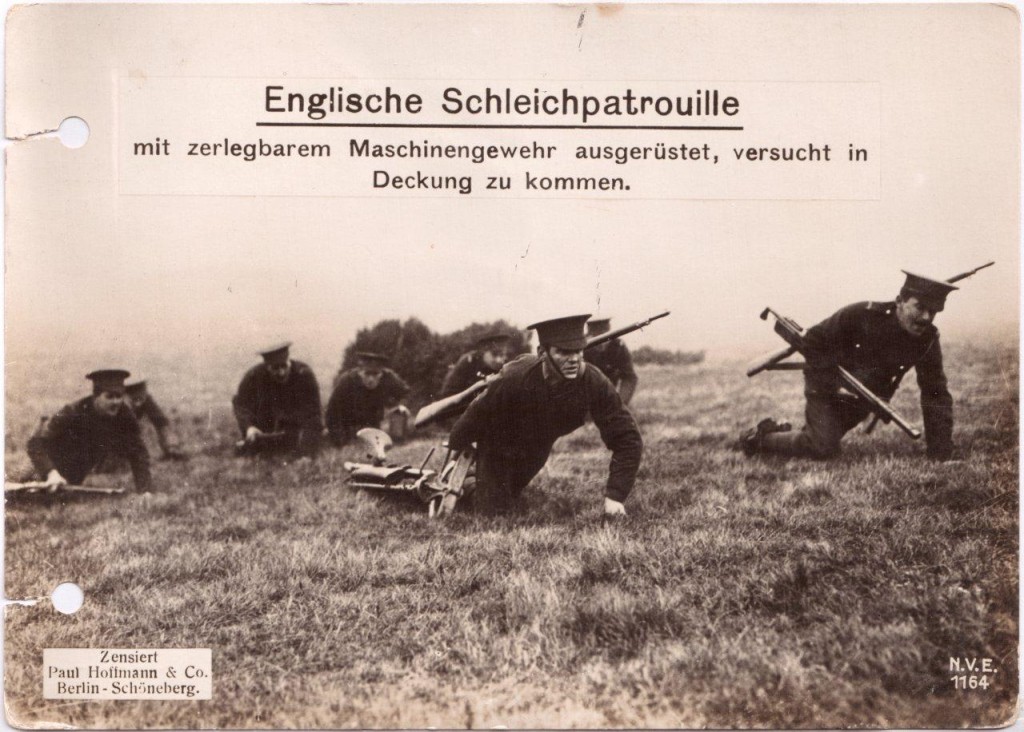
At first glance you wonder, “Why are those British sailors crawling around with their ship’s anchor?” Then you realize that they’re not sailors, and it’s actually a Colt 1895. The distinction may be lost on the guy carrying it, though. Rumor has it that his son served in WWII manning a Besa.


The Assistant Gunner is dragging a folded, portable tripod with triangular turn table and integrated bicycle-type gunner’s seat of the same type used for British 0.303″ Maxims from the late 1800’s onward that was featured in Ian’s Vintage Saturday post of August 11th, “For Queen And Country”.
This is intriguing as it would imply that the M1895 Colt “Potato Digger” was being used with the Maxim mount instead of the lighter Browning-designed tripod normally associated with it. As long as the locking pin was of the same size, the Maxim tripod would have accomodated the “Potato Digger” as it had a very tall pintle mount that provided sufficient clearance for the infamous downward-swinging operating piston of the gun.
There is a very good photograph on Page 38 of Ian Hogg’s “Machine Guns” showing two 0.303″ Maxims side by side on different mounts. The early-model gun in the foreground has the tripod seen above and in “For Queen And Country” ; the one in the background, which is a later model, has a simpler configuration where the gunner’s seat is mounted directly to the trailing leg of the tripod itself rather than on a separate swiveling wishbone assembly. The tripod legs are also of a different length and have larger rounded anti-skid feet. Although it is partially blocked by the gun in the foreground, I believe the later-model tripod probably also had a much smaller turn table and lower pintle height.
Small details…the picture was taken or published by a company in the Schoeneberg section of Berlin. my late brother, Tim and his GF at the time lived on Leuthenerstrasse in Schoenberg from 1986 until 1995 in full view of the ‘gas tower’ which was the main landmark of that section…their apartment had no central anything – heating nor water – it was built probably around the turn of the 20th century and had somrhow survived the Soviet destruction of the city…most likely gone now – replaced since the fall of the Wall on my 40th birthday – 9 Nov ’89.
Chris Brosnahan
Port St Lucie, FL
British soldiers skulking along the ground ! shocking behavior.
It’s almost like they don’t want to be mown down by machine gun fire !
Those soldiers look more like Canadians to me. Their rifles look more like Ross Mk III’s than long Lee’s. And I have read that the Canadians used the Colt-Browning early in the war before they received the Vickers.
My understanding is that this photo is of some Canucks. I’ll dig up my source did when I get home, but I’m certain I’ve seen this photo before, ID’d as canadians.
It could easily be Canadians. The German caption reads “English heavy patrol with disassembled machinegun moving into cover”. At the time, Canada was in a state of sort of quasi-independence, and I could imagine the distinction between Englishmen and men of the Commonwealth being lost to a turn-of-the-century German.
The tripod looks like a standard, tall digger tripod. Nothing at all like any Maxim tripod that I’m familiar with. In the image you are looking down onto the flat ‘cradle’ that the gun sits on. This is essentially a flat plate with two vertical ears and an arc sector below it. The pivot is just below the flat surface and there is a worm gear at the bottom of the arc to control elevation.
The following link is to a work of historical fiction entitled “The Rise, Fall, & Rebirth Of The ‘Emma Gees'” by Major K.A. Nette, PPCLI. It is a fascinating story detailing development of machine gun tactics by the CEF during the Great War, including indirect fire.
http://regimentalrogue.com/emmagees/emmagees1.htm
The full translation of the German text is “English surreptitious patrol, equipped with a take-down machine gun, is trying to reach cover”.
They are Canadian trops with MK111 Ross rifles and a Model 1914 Colt MG.Canada was one of the few countries to adopt the Model 1895/1914 MG
Regards
Alan David
Sydney